Almost all sellers at some point in their career will consider adopting a time management system to improve their productivity. Few stick with it. The challenge is that many time management systems focus too deeply on the activity level—what to do first, what to do next, what the priority order is—without paying enough attention to the bigger picture.
We studied the habits of extremely productive people—we call them The XP—in a global productivity research study with more than 5,000 participants to date. Not only did we learn their habits, we found that the most productive people are also more satisfied with their jobs, more likely to be top performers, and are happier.
We thought our research would show The XP manage their time to spend most of it on Investment activities now, so they could spend Treasured time later. However, that’s not what we found. We were surprised to see that The XP spend Investment and Treasured time now. No wonder they’re happier! They’re not sacrificing their Treasured time at the expense of work—they’re spending their time in the two most important areas and minimizing it in the other categories.
This makes a strong case to adopt their time management habits. Before we get to these time management tips, we want to help you better understand what time management is by giving you a new way to think about your TIME.
What Is Time Management?
Put simply, time management is the process of planning and being deliberate in how you spend your time.

We all have only 24 hours in each day. It’s how you choose to spend those hours that counts. We think about time management in 4 levels using the acronym TIME:
- Treasured
- Investment
- Mandatory
- Empty
4 Levels of TIME
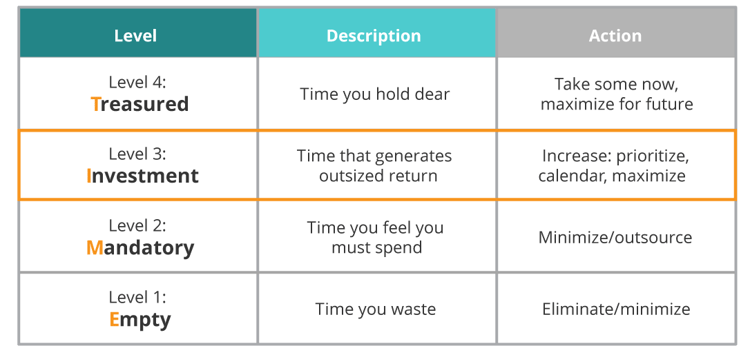
Treasured time is time you hold dear. Where we all want to get. For different people it means different things. Common examples include:
- Quality time with loved ones
- Vacation with friends and family
- Alone time
- Sports and games
- Work
- Hobbies
- Community service
- Your favorite TV show
If you spend the rest of your time wisely, you’ll find yourself with more time available for Treasured activities. Make enough money and you can retire early and do what you want with your time. Build the right work habits and not only will you boost your productivity, but you’ll also get more done in fewer hours and give yourself more Treasured time every day.
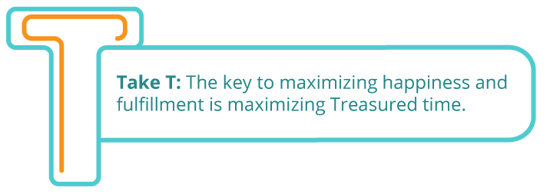
Investment time is the time you focus on becoming more effective, getting the right things done, and achieving top performance. You eventually get a return on your Investment time because it pays dividends to gain skills and knowledge, accumulate experience, and put in the extra effort that will lead to success. Investment time can also be personal, such as investing in exercise, which can in turn affect your professional success.

Mandatory time is time spent doing things you feel you must do (even if, in reality, you don't). Commuting to work, shaving, mowing the lawn, paying bills. All are examples of mandatory time. Note that just because you “feel” you must do something doesn’t mean you “should” do it.
You can minimize Mandatory time by:
- turning it into Investment time, such as listening to business books while you drive
- turning it into Treasured time by listening to books you enjoy, so you free time in the evening to do something else
- working from home or moving closer to where you work to minimize the commute
- delegating mandatory time to others, like hiring a landscaper to mow the lawn, using a delivery service for your grocery shopping, or having your laundry done at a fluff and fold
And you can actually reduce Mandatory time by questioning the activity itself. Does this need to be done at all? Does this need to be done by me?

Empty time is precisely as it sounds: time spent, nothing done, nothing gained. At least with Mandatory time, if you spend 30 minutes to get a haircut, your hair gets cut. If you’re just flipping through Facebook, watching YouTube videos, or reading Us Weekly, you’re simply letting time pass.
Now, it's quite possible you treasure this time. If that's the case, so be it. But most people would prefer to decrease the time they spend watching TV, playing games on the Internet, scrolling through Facebook, or puttering around the house aimlessly.
We all need some empty time. Just doing nothing or being mindless is important for recharging. We all need brain rest. However, most people have (and would like to) reallocate empty time to better use.

Everything you do, every minute of every day is spent in one of these four levels of time. With the right mindset and tools, you can completely redefine how you spend your time, and manage it more effectively.
Most time management systems are too complex. Instead, we suggest doing a few simple things to reclaim significant lost time (mandatory and empty time), then spend that time the way you want—on investment and treasured activities.
GET THE LATEST SALES TIPS, TOOLS, AND RESOURCES
Subscribe today to get the latest on virtual selling, insight selling, strategic account management, sales conversations, and more straight to your inbox.
How to Improve Time Management: Tips and Strategies
Here are time management techniques and strategies to help you see where your time goes now and figure out how to spend it more effectively.
1. Take Control of Your TIME: Take T, Increase I, Minimize M, Eliminate E
Our productivity research shows most people spend an average 4.3 hours per workday on Empty (wasted) and Mandatory (could be delegated or simply not done) activities.
That’s about half of every workday down the productivity drain.
Potential to Decrease Mandatory/Empty Time
Hours Spent Per Work Day
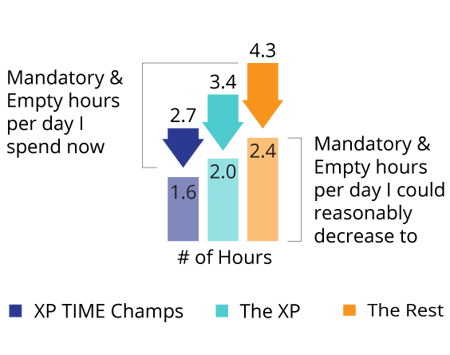
How you define activities within the TIME framework is deeply personal. It’s also dynamic—it changes depending on where you are and what you need in the moment.
Time is finite. If you're spending it on one thing, you're not spending it on another. Your goal might be to boost your productivity and minimize time spent in the Mandatory and Empty zones so you have more time to allocate to Treasured or Investment categories.
If you want to increase your productivity, you shouldn’t just make time management a priority; you must obsess over TIME.
Where does obsessing over TIME start? With understanding it, tracking how you spend it, and choosing how you should spend it.
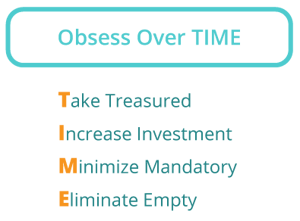
If you’re like most people, changing your Mandatory and Empty time habits will be hard. Delegating, eliminating, or minimizing your Mandatory and Empty time means changing habits.
Where people tend to spend their time on any given day is a reflection of how they are likely to spend time for months and years to come. Time is a habit. If you want to manage your time better, you first have to understand how you spend it.
Tracking your time is the best way to do that. Which brings us to tip #2...
2. Track Your Time
The key to effective time management is increasing your Investment time. When you do, you’ll eventually gain the financial freedom and independence to enjoy more Treasured time and do what you want.
To get started right now, keep a time log. This might sound boring. Who wants to spend time all day recording what they do, for how long, and what TIME category it falls under?
The reality is it doesn’t take that long. It's Investment time, and it works.
It's similar to keeping a food journal. According to a Kaiser Permanente study of 1,700 people, "those who kept daily food records lost twice as much weight as those who kept no records."
There's no doubt: if you want to optimize your time, you have to know where you’re spending it.
Do these three things to track your TIME:
-
Track activity and TIME level
When tracking, always note your activity (e.g., food shopping) and your category (e.g., Mandatory). Most time tracking software and apps (see the next point) will allow you to do this easily.

By tracking both, you can see what you're spending your time on, and you'll be able to make conscious decisions on how to minimize Mandatory and Empty time and maximize Investment and Treasured time.
-
Use technology and timers best suited to you
Absolutely use timers. You can use everything from a stopwatch on a watch, phone or desk, an online timer of which there are many, or those built into software like Toggl, RescueTime, TimeCamp, MyHours, or ATracker(which I use on my iPhone).
With ATracker, I set up my activities, including writing this article (Intellectual Capital Development) and categories (Investment). When I switch activities, such as when I feel like seeing what's in the news today, I simply click the next activity (e.g., Aimless Web Surfing and Empty), and it stops tracking time in the previous activity and starts tracking time against the new one.
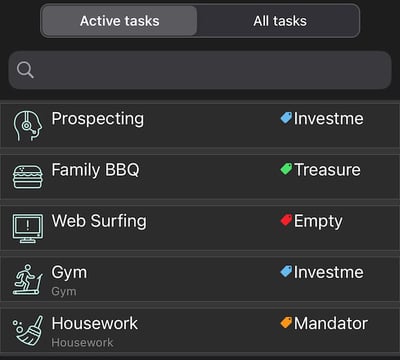
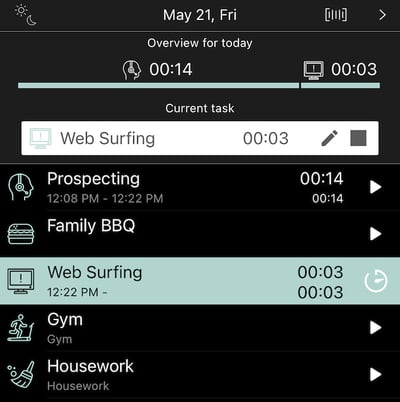
Create custom TIME categories Easily switch between pre-created tasks Worried you'll forget to switch activities? Some trackers require even less effort. With RescueTime, you install the app across your devices—phone, tablet, laptop, whatever—and let it run. It tracks your digital activity in painful detail, down to the second, and categorizes it into productive and unproductive time.
If tracking software isn't your thing, you can use a timer on your watch or desk, and simply track your time in Excel, a notebook, or a note taking technology like Notes on your phone, Microsoft Word, Evernote, or OneNote.
The method you use doesn't matter. What matters is that you are tracking your activities and TIME categories, in real time, with a timer.
-
Track in periodical obsessive daily chunks
It's impractical to track your time meticulously every single day. Carefully choose the days when you’ll do your obsessive tracking.
You don’t want to just ballpark your time tracking. Recording estimates at the end of the day—“three hours prospecting, two hours meetings, one and-a-half hours meals and breaks, two hours TV”—is anywhere from a little to extremely inaccurate. People tend to grossly overestimate the time they spend doing anything at work when looking back on activities. Record the actual minutes.
Your obsessive tracking days should be the work days or non-workdays you choose to 1) understand where your time really goes using timers and tracking in real time, and 2) focus on changing your time management habits.
As you track your time, keep the following in mind:
-
Be honest. People often lie to themselves when they track time. Don’t like that you got drawn into reading news articles for one and a half hours in the morning at work? Track it now; change it later.
-
You can enjoy something without it being Treasured time. Some people enjoy aimless social media scrolling, getting ready to go out for 45 minutes when 25 would do, or reading a magazine. When they’re honest with themselves, however, most people trying to more effectively manage their time or drive their careers forward would like to spend less time on these kinds of activities.
-
Don’t target zero Empty or Mandatory time. You can’t get to zero, and you don’t want to. Sure, you can convert Empty time like commuting into Investment time if you listen to business books or podcasts. Human brains, however, need some downtime. Also, if you target zero Mandatory time, you’ll tend to get angry when you have to do something that you don’t want to. Accept that it happened, do what you must if you must, and make a plan to reduce it in the future.
Consider that the average adult underestimates the amount of time they spend watching TV by one full hour per day. Most adults actually watch 30 hours of TV per week—an average of a whopping 4.3 hours a day!—but they think they watch 20 hours a week.
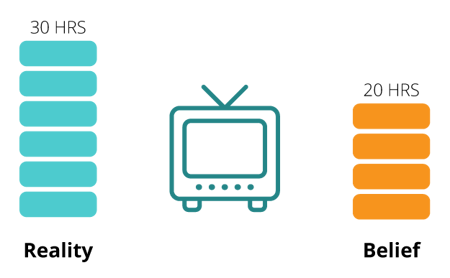
Be honest. Be realistic. You don't have to target zero hours watching TV, but if you're like most people, you could gain 10 hours per week if you truly watch the amount of TV that you think you watch.
The sooner you figure out where your time is going, the sooner you can start maximizing time spent on what's important to you.
So, choose periodic days to track obsessively. Make it a priority and track in real-time to the minute.
3. Put Your GIA First
During each day, you expend energy. Energy is a renewable resource, but as you’re using it, you lose it. If you spend two hours plowing through email, taking care of Mandatory items, or putting out fires, your tank is no longer full.
What should you do? Put your Greatest Impact Activity (GIA) first. When you work on your GIA first, you start with a full tank. The body of research suggesting that energy, memory, concentration, and analytical skills are better in the morning for most people is indisputable.
For instance, based on a study of two million students in Los Angeles County, researchers found math and English GPAs are higher when students take those classes in the morning versus the afternoon. Other studies show task completion accuracy and speed are better in the morning. Alertness is better in the morning, too (though with a burst in the evening). Doctors diagnose better, and get better surgical results, in the morning, and people’s logic is better then, too.
If you have something important to do, odds are you want to do it first thing in the morning. The XP do just this. Almost half of The XP put their GIA first—but just a little more than one in ten of The Rest do.
Start with Greatest Impact Activity

While morning is better for most people’s energy and concentration, for some people it’s better in the afternoon, evenings, or late at night. If this is you, then put your GIA at that other time.
That is, if you think you will definitely get to it and not push it off for another day.
This is one of our most effective time management strategies, so pay close attention. Don’t let your most important activity fall off or to the bottom of your to-do list. Put your GIA first.
4. Plan Your TIME
When you know what you want to accomplish each day, you can define activities that will get you there (your GIAs) and map out when you will spend your time on them.
As the definition states, to manage your time well, you must plan how you'll spend it. Without planning, you aimlessly wander around the internet, up and down the halls, on social media, and you react to the first to-do list item that catches your attention. I can almost guarantee whatever that item is, it’s not going to be your GIA.
Plan your actions weekly and calendar your GIAs and other investment time. All it takes is 15 minutes on Friday, Sunday, or Monday to map out your week. In fact, calendaring Investment activities was one of the key drivers of Extreme Productivity in our research.
Calendar Your GIAs and Investment Time
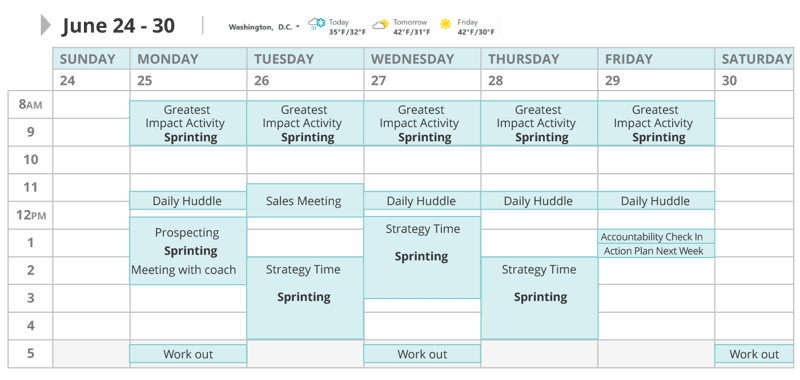
Furthermore, research conducted by Sarah Milne, a psychologist at the University of Bath in the UK, found that committing to a specific plan to perform an activity, including time and dates (i.e., calendaring activities), makes you significantly more likely to tackle the activity.
Let's say you need to fill your sales pipeline. Your goal may be to generate 15 new meetings this month. Set this as your GIA and then calendar time each day to work on it. Block off the first 2 hours of the morning for obsessive focus on prospecting with no distractions. Don't allow others to set meetings during this time. When the meeting notice goes off, say to yourself, "3, 2, 1…Go!" and begin your prospecting efforts. If you don’t know where to start with any given task, break it down into smaller tasks and calendar those activities (e.g., build a list of 50 target companies, reach out to 10 past clients, etc.).
When it comes to calendaring, planning, and tracking time, focus on activity over outcomes. You can control that you spend X number of hours concentrating on a specific activity, but you can’t necessarily control the outcome, which, in this case, is how many meetings you set.
5. Focus and Sprint into the Zone
The zone is the mental state where a person performing an activity is fully immersed in a feeling of energized focus, full involvement, and enjoyment in the process of the activity. Mihaly Csikszentmihalyi developed the most well-known, fully fleshed-out theory of the zone in his book, Flow: The Psychology of Optimal Experience. As the subtitle suggests, the zone is about much more than being productive, because when you find yourself in it, you’ll feel more confident, engaged, and happy.
When you're in the zone:
- Time feels suspended—you barely notice it passing, and yet it's really flying
- You feel extreme focus
- You aren't just happy, you feel euphoric just by focusing on and working on the task
- The task feels increasingly effortless
- You feel in control and confident the activity is doable
- You feel rewarded simply by engaging in the activity
If you want to maximize effort per work hour, get in the zone.
If you want to get in the zone, establish a daily routine of obsessed, planned Sprints.
Sprinting is a form of timeboxing. A popular technique in many project-management and software-development methods, timeboxing allocates a specific time period (or time box) to a pre-planned activity.
The three guidelines for TIME Sprinting are:
- Sprint: Work on a planned task for 20 minutes minimum with a visual stopwatch counting up. If you reach 90 minutes, take a break.
- Relay: Perform four TIME Sprints in a row with up to 6-minute breaks in between. Each 4-sprint-in-a-row sequence is a Relay.
- Block distraction by keeping a distraction capture list: If you feel a distraction, don’t switch tasks. Keep a notepad handy and write down the distraction. Return to sprinting on your chosen task.
Here’s what to do. Work obsessively on one planned task only for 20 to 90 minutes with a visual stopwatch on, counting up. If you reach 90 minutes, take a break. By using a stopwatch instead of a timer, your concentration won't be interrupted by a timer going off. Using a stopwatch may seem like a small change, but it feels significantly different.
When you’re using a stopwatch, you might glance over at it and see that only five minutes have gone by. This is your signal to keep focusing.
You still have 15 minutes before you allow yourself to pour that coffee, check your messaging, open a browser, or do anything except obsess over your selected task.
Next thing you know, you could be flying through work. At that point, if the work is flowing, you can keep going until the 90-minute mark. Or take a break. Your choice.
The suggestion that you stop at 90 minutes is based on the cyclical rhythm of human rest and wakefulness. Your attention and focus will naturally decline at this point. Of course, you can keep going, but 90 minutes is generally a good time to take a break.
6. Say No
"No" is powerful. It's the one word most responsible for allowing people to take control of their time. Those who say 'yes' to everyone else leave little time to work on their own priorities.
Many people have a hard time saying no because they don't want to let others down. You want to be seen as a team player. You want to be liked. You don't want conflict. So you say yes, even when it means sacrificing your own goals, priorities, and even happiness.
It takes courage to say no. This simple two letter word can set you free.
When you say no to others, you're saying yes to your priorities. Saying no allows you to do your job instead of someone else's.
Embracing the "say no" philosophy doesn't mean you have to say it in an off-putting way. When saying no to a boss, colleague, or even a potential customer, you can decline their request in a way that lets them down gently but still delivers a clear no.
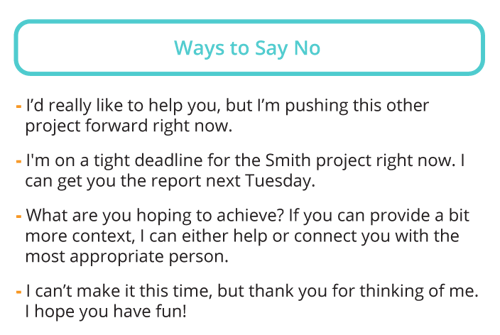
It's okay to say no. Turning others away gives you more time to concentrate on what's most important for you. Indeed, it allows you to manage your own time more effectively. Be mindful of how you communicate saying no to these requests and you'll be able to focus on your own priorities while still maintaining positive working relationships.
7. Play Hard to Get
You know your priorities and you've carved out time to focus on them. You've said no to the mandatory tasks on your list. You've cut out Empty time. You start working and...
Ding...Knock...Buzz...Ring
Distractions and interruptions derail your focus and steal your time. Instead of being a slave to these interruptions, what if you:
- Turned off all notifications—email, Slack, texts, social media, etc.
- Put your phone on Do not Disturb and tucked it away in a drawer
- Closed your office door
- Moved to a different office or conference room
- Worked from home or the library
By doing any, or all, of these things, you become impossible to distract. If people can't find you or get a hold of you, they can't interrupt you.
Now, this isn't to say you should never interact with coworkers. But when you need to concentrate, make sure you can't be disturbed.
Start Today
Everyone feels they need more time in their days; 24 hours simply doesn't seem enough. However, most people who apply these time management strategies find significantly more time to achieve their goals, and indeed, to make themselves happier.
You can immediately begin using the TIME framework and these tips and strategies:
- Take Control of Your TIME: Take T, Increase I, Minimize M, Eliminate E
- Track Your Time
- Put Your GIA First
- Plan Your TIME
- Focus and Sprint into the Zone
- Say No
- Play Hard to Get
To learn how to take advantage of all 9 habits and 27 hacks used by extremely productive people, download the ebook Unlocking the Productivity Code.
Erica Schultz, Chief Marketing Officer here at RAIN Group, talks more about managing your TIME in the video below.






